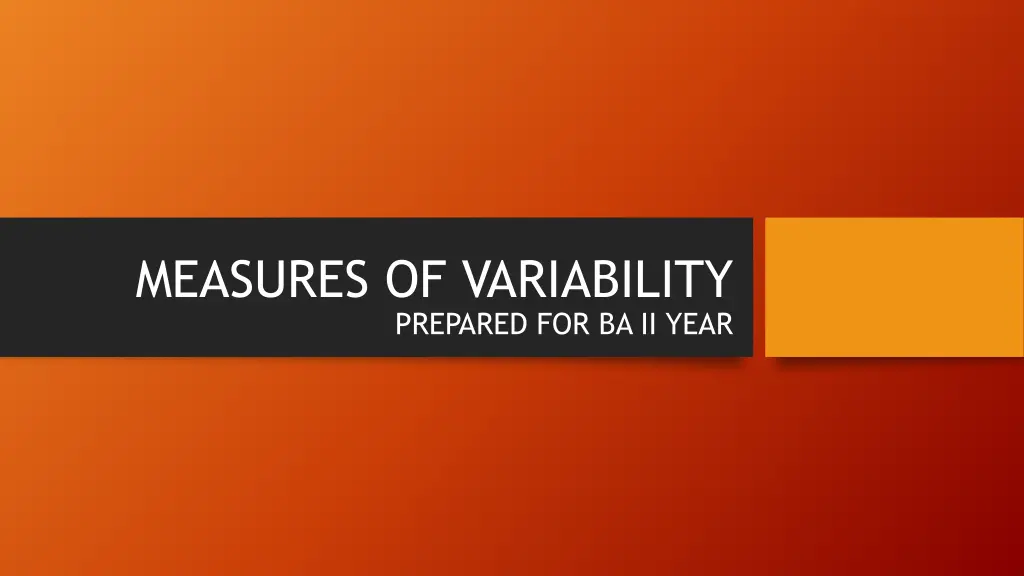
Understanding Measures of Variability in Data Analysis
Learn about measures of variability, such as range and standard deviation, which help analyze dispersion and variation in data sets. Explore how to calculate standard deviation from both individual and grouped data, with practical examples included.
Download Presentation

Please find below an Image/Link to download the presentation.
The content on the website is provided AS IS for your information and personal use only. It may not be sold, licensed, or shared on other websites without obtaining consent from the author. If you encounter any issues during the download, it is possible that the publisher has removed the file from their server.
You are allowed to download the files provided on this website for personal or commercial use, subject to the condition that they are used lawfully. All files are the property of their respective owners.
The content on the website is provided AS IS for your information and personal use only. It may not be sold, licensed, or shared on other websites without obtaining consent from the author.
E N D
Presentation Transcript
MEASURES OF VARIABILITY PREPARED FOR BA II YEAR
WHAT IS MEASURE OF VARIABILITY MEASURES THAT TELLS ABOUT DISPERSION OR VARIATION ARE CALLED MEASURES OF VARIABILITY. IN A GROUP INDIVIDUALS ALWAYS HAVE DIFFERENT SCORES ON CERTAIN VARIABLES, FOR DIFFERENT GROUPS THESE DIFFERENCES ARE ALWAYS VARY, THAT SHOWS DEVIATION FROM CERTAIN POINT OF SCORE. THIS DEVIATION IS CALLED AS VARIABILITY. GROUP A 18, 18, 18, 18, 18 GROUP B 17, 18, 18, 18, 19 GROUP C 16, 17, 18, 18, 19 GROUP D 16, 17, 18, 19, 20
RANGE RANGE IS THE DIFFERENCE OF HIGHEST SCORE FROM LOWEST SCORE IN A GROUP. GROUP A= (18-18)+1=1 GROUP B=(18-17)+1=2 GROUP C= (18-16)+1=3 GROUP D= (18-16)+1=3
STANDARD DEVIATION THIS IS THE MOST WIDELY USED AND BEST MEASURE OF VARIABILITY. IT DEPENDS ON ALL THE SCORES. STANDARD DEVIATION IS SQUARE ROOT OF AVERAGE OBTAINED FROM SQUARES OF DIFFERENCE BETWEEN SCORES FROM ITS MEAN VALUE FOR A GROUP. IT S VALUE ALWAYS REMAIN POSITIVE. IT IS DENOTED BY S.D. OR (SIGMA). S. D.= ? ? ?2
??2 ? S.D.= WHERE, X= SCORES M= MEAN N= TOTAL NUMBER OF SCORES (X-M)2=SUMMATION OF SQUARE OF DEVAITION OF SCORES FROM MEAN VALUE
FIND OUT STANDARD DEVIATION OF THE FOLLOWING SCORES: 8,9,10,13,15 X 15 13 10 9 8 X=55 x OR (X-M) 15-11=4 13-11=2 10-11=-1 9-11=-2 8-11=-3 x =0 x2 OR (X-M)2 16 4 1 4 9 x2=34 ? ?2 ? = =34/5= 6.8=2.61
STANDARD DEVIATION FROM GROUPED DATA ? ? ?2 ?? = ? WHERE,f= FREQUENCIES OF DIFFERENT CLASSES X= MID POINT OF DIFFERENT CLASSES M=MEAN f(X-M)2=SUMMATION OF MULTIPLICATION OF FREQUENCY AND SQUARE OF DEVIATION OF SCORE FROM MEAN
CLASS 50-54 45-49 40-44 35-39 30-34 25-29 20-24 15-19 i=5 f 1 6 8 10 12 8 3 2 N=50 X 52 47 42 37 32 27 22 17 fX 52 282 336 370 384 216 66 34 1740 fX2 2704 13254 14112 13690 12288 5832 1452 578 63910 X-M 17.2 12.2 7.2 2.2 -2.8 -7.8 -12.8 -17.8 (X-M)2 295.84 148.84 51.84 4.84 7.84 60.84 163.84 316.84 F(X-M)2 295.84 893.04 414.72 48.40 94.08 486.72 491.52 633.68 3357.32 3358 50 =8.195 =
CALCULATING SD USING SHORT METHOD ??=? ??2 2 ?? ? FROM ASSUMED MEAN WHERE, d= DEVIATION OF DIFFERENT CLASSES ? CLASS 50-54 45-49 40-44 35-39 30-34 25-29 20-24 15-19 i=5 f 1 6 8 10 12 8 3 2 N=50 d 4 3 2 1 0 -1 -2 -3 fd 4 18 16 10 0 -8 -6 -6 f d=28 Fd2 16 54 32 10 0 8 12 18 fd2=150 SD=5 =5 = 5 =5 =5*1.639 =8.195 (150/50)-(28/50)2 (3-.56*.56) (3-.3136) 2.6864
USE OF RANGE IT IS USED FOR CRUDE AND QUICK MEASURES. IT IS USED WHEN SCORES ARE WIDELY DISPERSED. RANGE IS USED WHEN INFORMATION RELATED TO EXTREME SCORES ARE KNOWN ONLY.
USE OF STANDARD DEVIATION THIS IS THE MOST STABLE VALUE FOR VARIABILITY. THIS IS USED WHEN MEAN IS USED FOR CALCULATION. IT IS USED WHEN SCORES ARE ARRANGED ACCORDING TO THEIR WEIGHTAGE. STANDARD DEVIATION IS USED WITH HIGHER LEVEL OF STATISTICS SUCH AS STANDARD DEVIATION AND CORRELATION.
